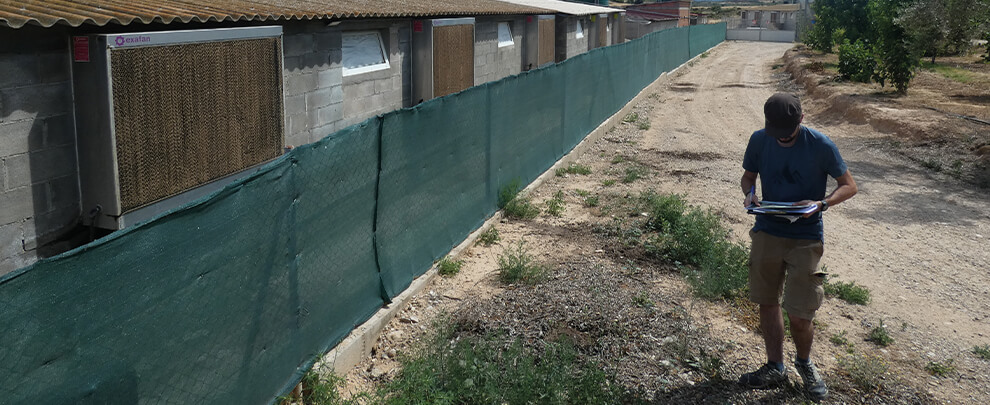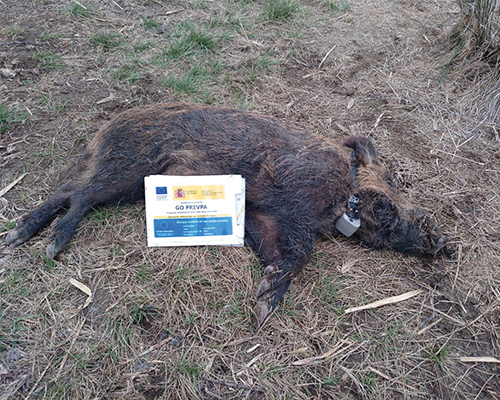Blog
Blog

African Swine Fever: Biosecurity and wild boar control strategies
31st March 2025 - News
The wild boar has become a key element in transmitting diseases that threaten pigs' health in Europe, especially African Swine Fever (ASF). Their expansion and behaviour increase the risk of contact with domestic pigs, which worries the sector. Mario Sebastián Pardo, an expert from the Institute for Research in Game Resources (IREC), explains how wild boar populations influence the epidemiology of ASF and tells us about the work they do to control them with advanced technology.

Mario Sebastián Pardo, from the Game Resources Research Institute. Photo: M.S.
What characteristics make wild boar a key factor in transmitting diseases such as ASF to domestic pigs?
We could differentiate three main characteristics. First, wild boar is the same species as the pig, Sus Scrofa. Therefore, a pathogen that infects one can be transmitted to the other without problems. Another critical factor is that wild boar is widely found in Europe, even in urbanised environments. Therefore, it is highly likely that it will interact with humans or livestock. The third factor is that wild boars have an excellent capacity for reproduction; even females can reproduce before the first year, so their capacity for expansion and growth is very high.
What impact does the expansion of wild boars have on the risk of transmission of diseases such as ASF?
Until now, ASF has been transmitted mainly in two ways. On the one hand, long-distance outbreaks have been generated by introducing contaminated materials in meat products or other elements such as feed. On the other hand, at short distances and in a much more diffuse way, it has been transmitted through wild boar populations, as in the case of the entry of the virus into Germany from Poland. Some cases have been controlled, thanks to rapid action to isolate the outbreak, as happened in the Czech Republic in 2017 or in Belgium in 2018, but those that have entered through wild boar have not yet been eradicated in any country. Therefore, wild boars are the most challenging entry route for ASF to control.
Why is understanding wild boar populations' spatial and temporal patterns essential?
Typically, wildlife monitoring programmes should include two aspects: the health status of populations and their demographic parameters. This way, we could know more accurately how many animals are infected from the total population. This would allow us to know the actual consequences of the management measures and, above all, the real impact of the disease on populations. Otherwise, we would only have a tiny part of what is happening.
At IREC, what technological tools do you use to monitor the interaction between wildlife and pigs, and what key data have you obtained?
IREC has been working on studying wild boar populations for a long time and has used a relatively wide variety of tools. Perhaps the least "technological" are the questionnaires, which I have done the most but which allow us to identify the risk points for the interaction. In other words, photo trapping has been used, a technology that consists of the placement of a camera that is activated when the animal passes in front of it, and it allows for defining the use that the animals make of resources. Telemetry systems such as GPS collars or proximity sensors have also been used, making it possible to see the frequency of use of specific risk points or even quantify interactions between species. Finally, we have also worked with drones to see the abundance of different reservoirs and to predict the risk of pathogen transmission.
What data have you been able to get from using these technologies?
Traditionally, where we have worked the most has been in the southern part of the peninsula, and what we have been able to verify is that indirect interactions in extensive livestock environments are the most relevant for the transmission of pathogens, at least in Mediterranean environments of the pastureland, and that the abundance of hosts is a risk factor for the interaction between wildlife and livestock. It has also allowed us to determine the key elements to consider in improving farms' biosecurity.
What are the main challenges when working with these technologies?
Here, I would differentiate between the challenges of fieldwork and data processing. In fieldwork, of course, the weather and environmental conditions, such as relief and accessibility, of some sites make the placement of the cameras quite complicated. Another handicap is the theft of these. There are around 10% of stolen cameras compared to those placed. However, the main difficulties are in the subsequent processing and analysis of photos. About 40 cameras are placed at each point, and tens of thousands of images are generated, which must be stored and classified. We now have several artificial intelligence tools that help us pre-classify photos and other technological tools to calculate the density of wild boars.
After conducting audits and field studies on pig farms, what have been the main risk points identified for external biosecurity?
Biosafety audits are carried out in three phases. The first consists of collecting information through the staff or the veterinarian. After this first step, we visit the farm to interview the workers or the manager and make a transect, looking for signs of wild areas or identifying risk points. Finally, these risk points are characterised, and corrective measures are proposed, such as anchoring the lower part of the fence to a concrete slab. In the different intensive farms where we have carried out these audits, we have been able to identify five risk points: perimeter fencing, slurry ponds, water ponds, feed storage silos and carcass containers. In addition, attention should also be paid to whether there are any elements around the farm, such as pools of water, patches of forest or crops, that can act as an attractive element for fauna. And finally, biosecurity in the activities of livestock farm personnel is essential.

Quick detection and removal of carcasses is essential to prevent transmission of the virus to domestic pigs. Photo: M.S.
Considering these critical points, what external biosecurity measures do you think are a priority to prevent contact between wild boar and domestic pigs?
All the measures we can take are necessary because wild boar can pollute the environment of farms. So, any measure that prevents pathogens from entering the farm is significant. But from our point of view, the perimeter fencing, which in the end prevents wild boars from entering the farm, would be the point to which we should pay the most attention. The farm, slurry, and water ponds are crucial to preventing the wild boar from being attracted to or entering the farm. It should be buried or reinforced at the bottom to make the fencing safer. Personnel are also critical; they must scrupulously respect the separation between clean and dirty areas and avoid introducing pork products. These measures should be accompanied by effectively controlling wild boar populations.
What additional strategies could be implemented in the long term to reduce the risk of ASF transmission through wild boars?
To prevent the entry of ASF, it is necessary to work on several pillars and maintain them over time: monitoring of wild boar populations, routine control of their populations (in the absence of ASF) and rapid action in the event of an outbreak. For the first point, the combination of abundance models based on hunting statistics with photo-trap points and systematic and harmonised health monitoring between different autonomous communities and countries is required. In addition, it is necessary to work so that the group of hunters or other professionals in their absence can effectively control the populations through different methods. Developing and updating action protocols is necessary for the latter, promoting coordination between the various administrations and fine-tuning them through frequent drills so that all the gears fit together perfectly. These protocols can include new technologies, such as using drones to census the animals in an area, increase the efficiency of hunting, and, in the event of an outbreak, locate and remove infected wild boar carcasses as soon as possible.
The IREC promoted the FAUNET project to monitor wild boar populations. Can you explain its components?
The Sub-Directorate General of Livestock and Hunting Productions of the Ministry of Agriculture, Fisheries and Food funds the project. Through photo trapping, it seeks to reliably determine wild boar densities in representative areas of the peninsula, making it possible to calibrate models based on hunting statistics collected throughout the country so that reliable density estimates can be obtained at the national level. A correct analysis can be carried out of risks to prevent the entry of ASF. The project started in 2023 and has obtained data on wild boar densities in 17 representative points of the Iberian Peninsula. In addition, a protocol for the determination of wild boar density using drones and the use of AI is being developed.
Finally, what benefits do you hope this project will bring to the pork sector?
From the densities calculated with photo trapping, obtaining information at the national level will allow us to identify areas where the risk of interaction between wild boar and domestic pigs is high. Therefore, we can focus on preventive and monitoring measures in these areas to make a more efficient management of resources. We will also have tools for urgent use in an outbreak of ASF in wild boar. This will allow us to eliminate the infected population immediately and reduce the risk of virus transmission outside the initial outbreak. This is essential to ensure that our export market is opened once possible outbreaks of ASF are controlled.






